

Space Designed for Lifelong Learning: The Dr. Martin Luther King Jr. Joint-Use Library. Next essay in this report >> | previous essay >> | report contents >> Christina A.
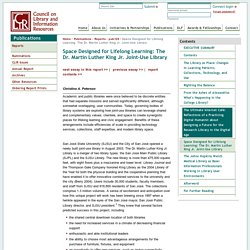
Peterson Academic and public libraries were once believed to be discrete entities that had separate missions and served significantly different, although somewhat overlapping, user communities. Today, governing bodies of library systems are exploring how joint-use libraries can leverage shared and complementary values, clientele, and space to create synergistic places for lifelong learning and civic engagement. Benefits of these arrangements include efficiencies of scale in providing technology services, collections, staff expertise, and modern library space. San José State University (SJSU) and the City of San José opened a newly built joint-use library in August 2003. One major planning issue was the degree to which services, collections, and operations would merge.
Martin Luther King Jr. King Library is a merger of two very traditional libraries, one academic and one public. Lessons from Year One. From the Ashes of Alexandria: What's Happening in the College Library? Next essay in this report >> | previous essay >> | report contents >> Sam Demas Creating the New Alexandrias For several generations, academic librarians were primarily preoccupied with the role of their library buildings as portals to information, print and later digital.1 In recent years, we have reawakened to the fact that libraries are fundamentally about people—how they learn, how they use information, and how they participate in the life of a learning community.
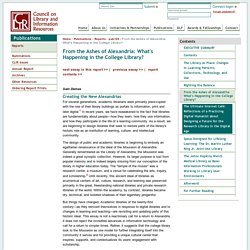
As a result, we are beginning to design libraries that seek to restore parts of the library's historic role as an institution of learning, culture, and intellectual community. The design of public and academic libraries is beginning to embody an egalitarian renaissance of the ideal of the Mouseion at Alexandria. But things have changed. The promise of digital libraries speaks to one key part of the Alexandrian ideal: to provide access to a "universal collection. " Why Do People Come to Libraries?
Individual Study Group Study. The Library as Place: Changes in Learning Patterns, Collections, Technology, and Use. Next essay in this report >> | previous essay >> | report contents >> Geoffrey T.
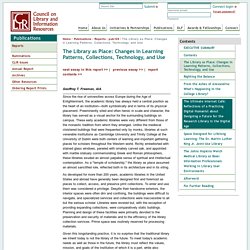
The Library as Place: Changes in Learning Patterns, Collections, Technology, and Use. Web Magazine for Information Professionals. The Value and Impact of University Libraries - resources for CAUL. The following survey of resources has been compiled by CAUL's Quality & Assessment Advisory Committee (CQAAC): The context for many of the resources listed here arises from the need for libraries to prove their value: Not only do stakeholders count on higher education institutions to achieve their institutional goals, they also require them to demonstrate evidence that they have achieved them.
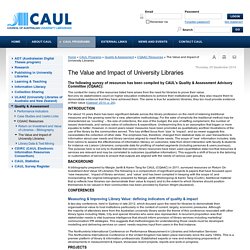
The same is true for academic libraries; they too must provide evidence of their value (Oakleaf 2010, p. 26). For about 10 years there has been significant debate across the library profession on the merit of retaining traditional measures and the growing need for a new, alternative methodology. Looking for the Link Between Library Usage and Student Attainment. In 2010, the University of Huddersfield shared results from its analysis of anonymised library usage data [1].
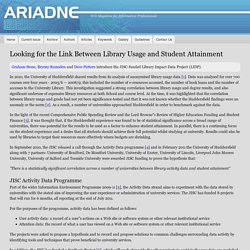
Data was analysed for over 700 courses over four years - 2005/6 — 2008/9; this included the number of e-resources accessed, the number of book loans and the number of accesses to the University Library. This investigation suggested a strong correlation between library usage and degree results, and also significant underuse of expensive library resources at both School and course level. At the time, it was highlighted that the correlation between library usage and grade had not yet been significance-tested and that it was not known whether the Huddersfield findings were an anomaly or the norm [2]. As a result, a number of universities approached Huddersfield in order to benchmark against the data. "There is a statistically significant correlation across a number of universities between library activity data and student attainment" JISC Activity Data Programme.
School Libraries Impact Studies « Library Research Service. Library Research Service School Libraries & Student Achievement (2013) This 1-page infographic presents highlights from all of LRS’s school library impact studies.

Two versions of the infographic are available: – One is optimized for online viewing – And, the second is optimized for printing If you view the infographic PDF file in Firefox PDF viewer, it may not render properly. For best viewing and printing, click on the “open in different viewer” button in the top right corner of your browser, and select the option to open the file with Adobe Reader. The PDF file is optimized for printing on legal size paper. Discovering the Impact of Library Use and Student Performance. Brian Cox is Manager Quality and Marketing, and Margie Jantti is University Librarian at the University of Wollongong Library.
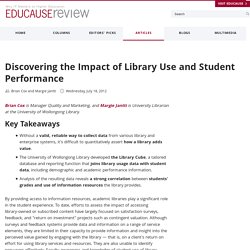
Key Takeaways Without a valid, reliable way to collect data from various library and enterprise systems, it's difficult to quantitatively assert how a library adds value. School Libraries Impact Studies « Library Research Service.
School Libraries around the world.